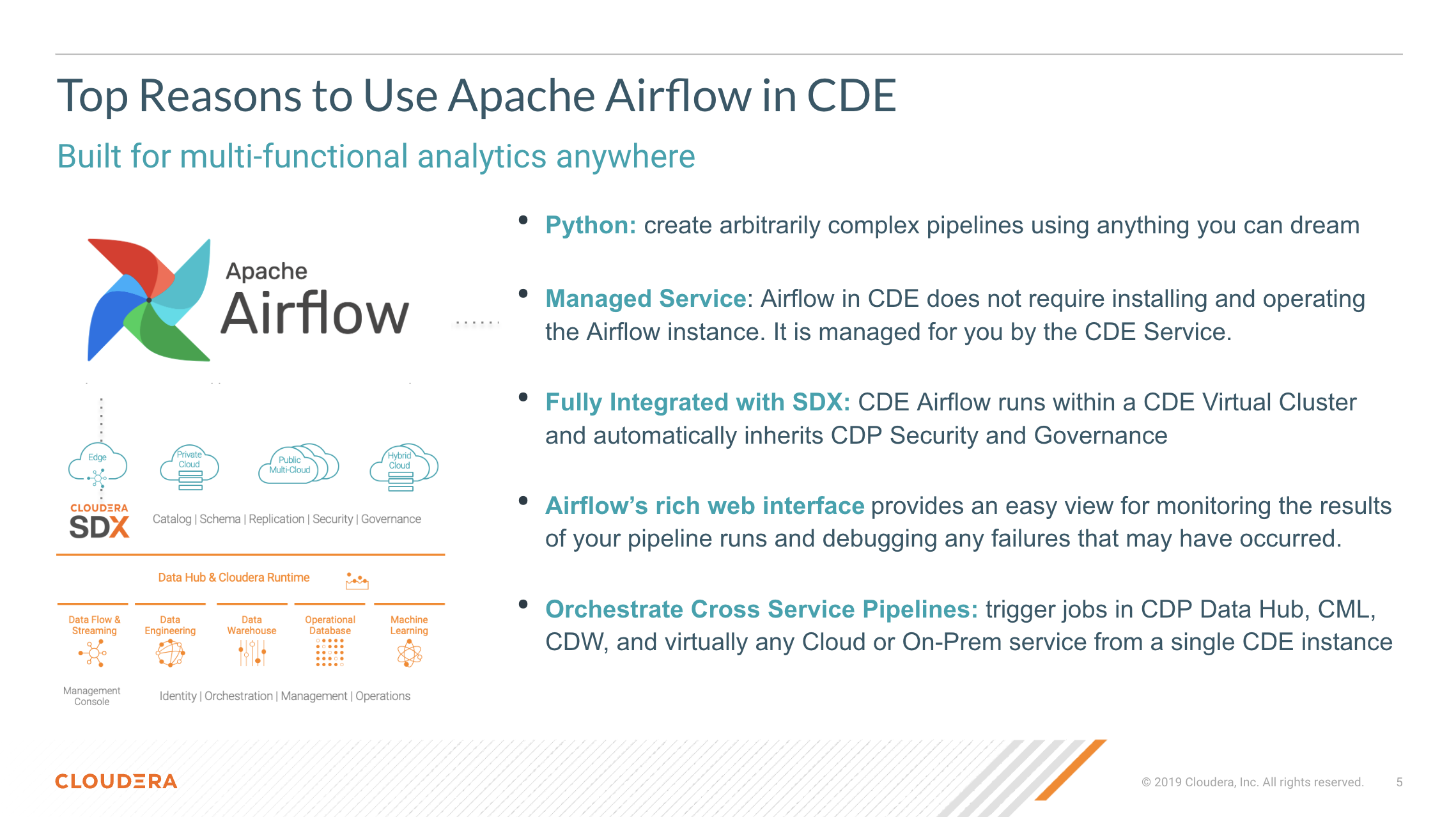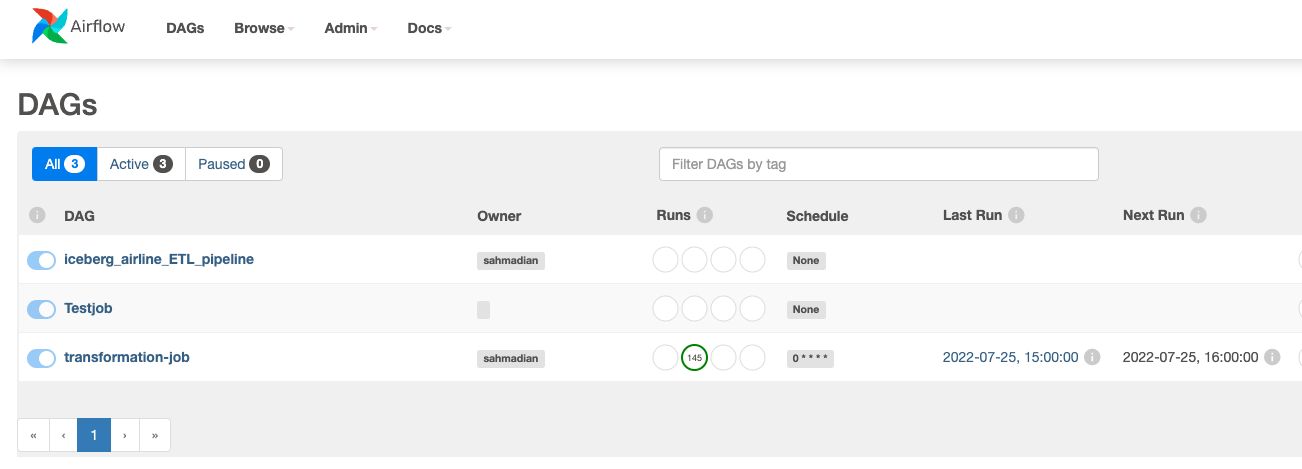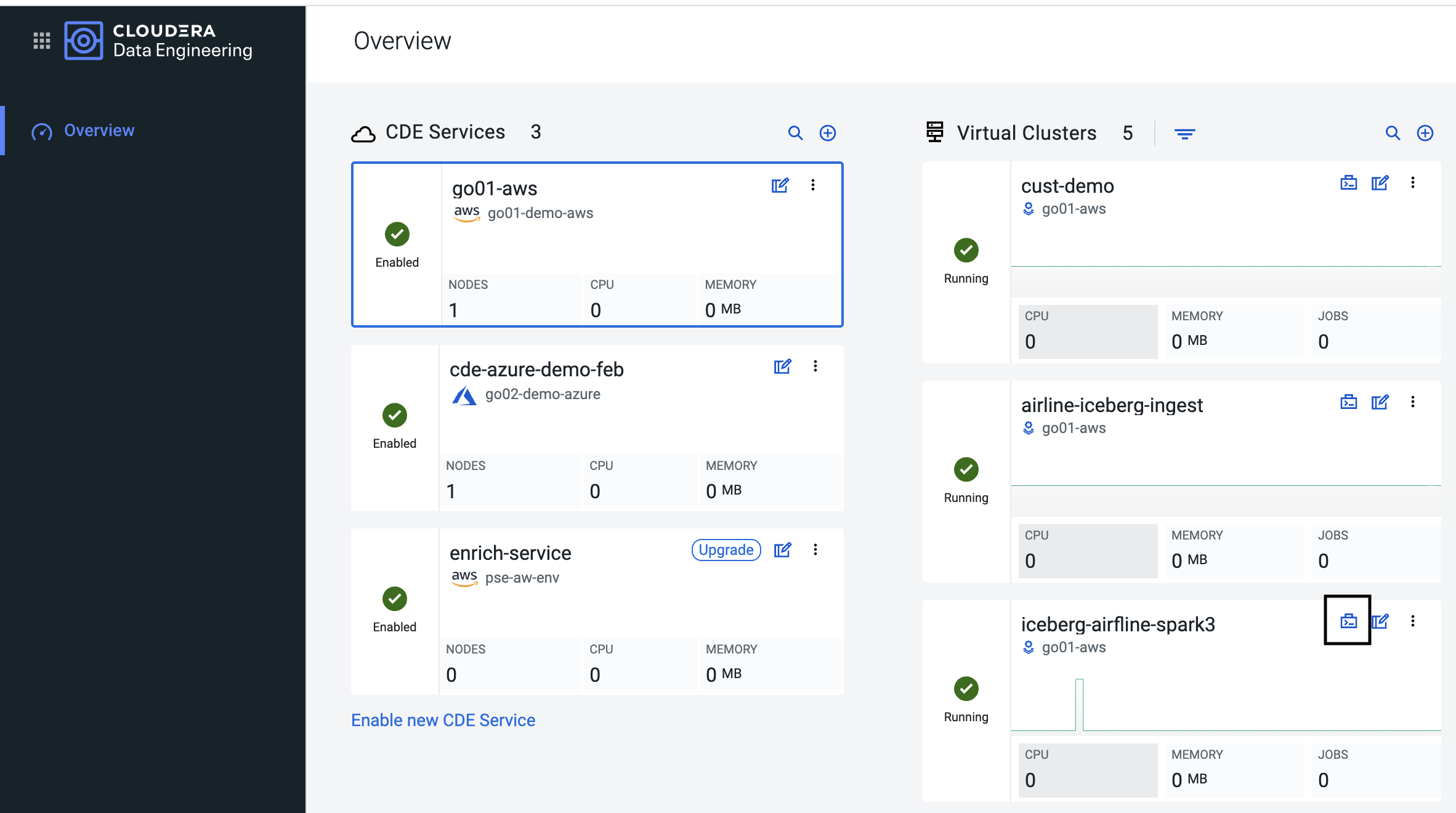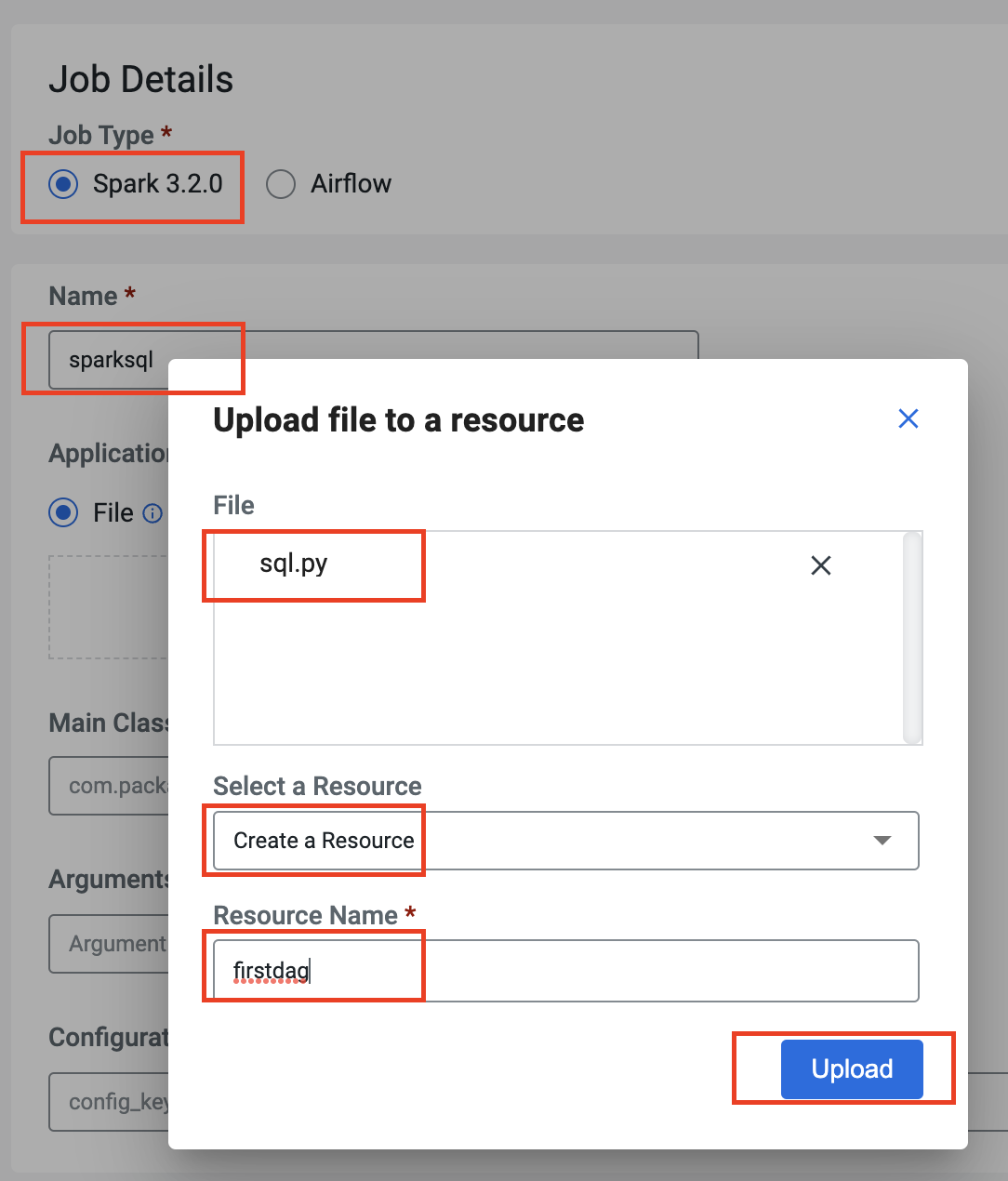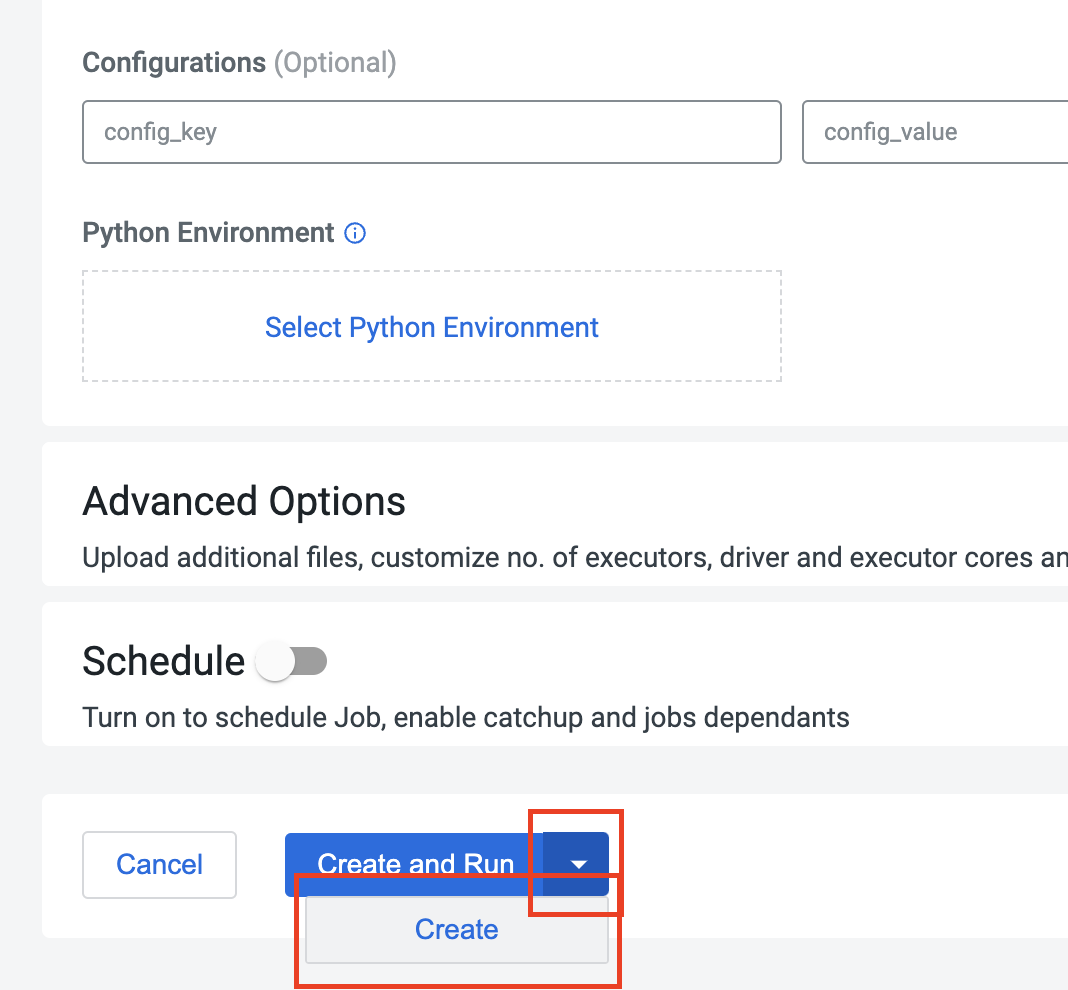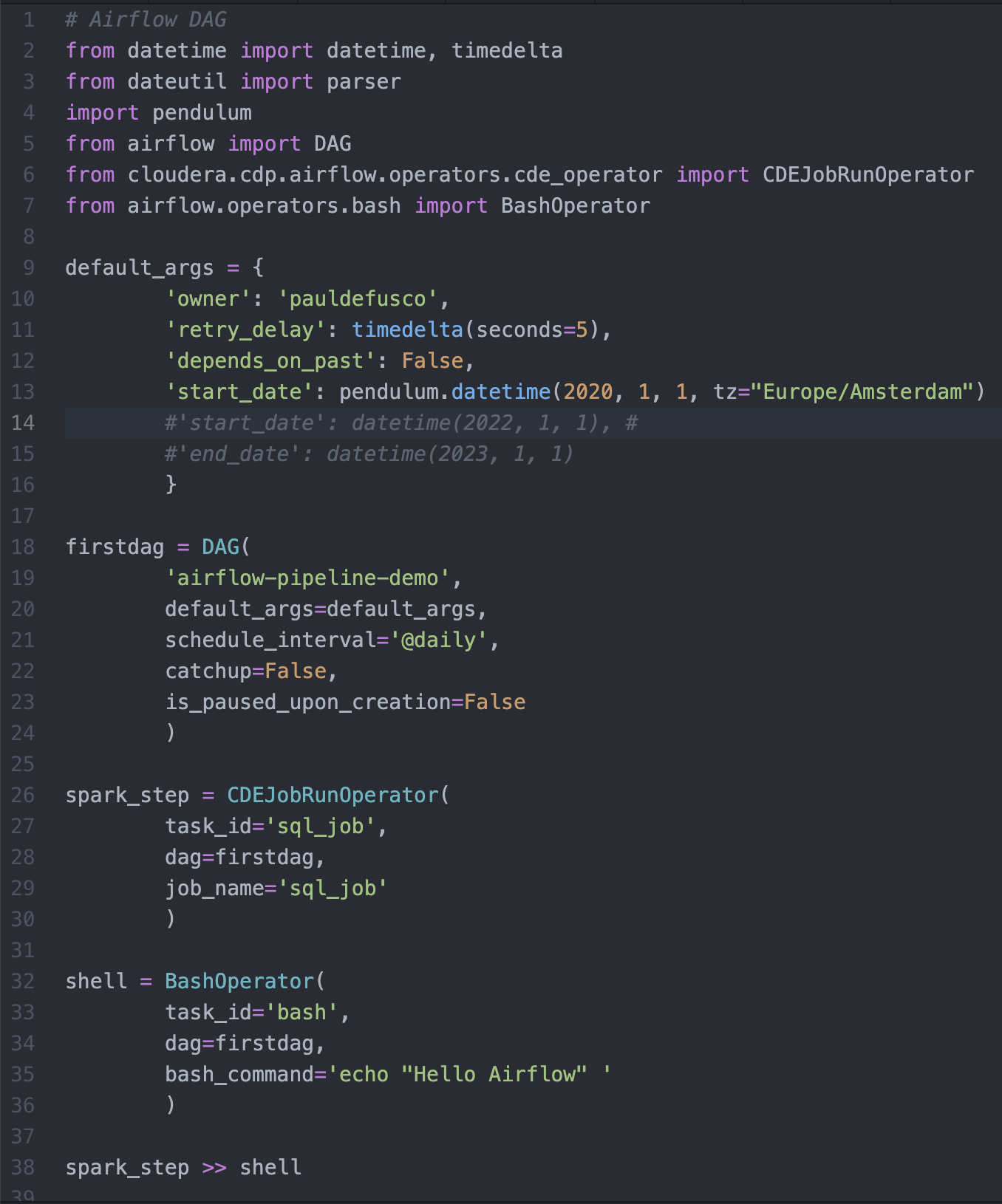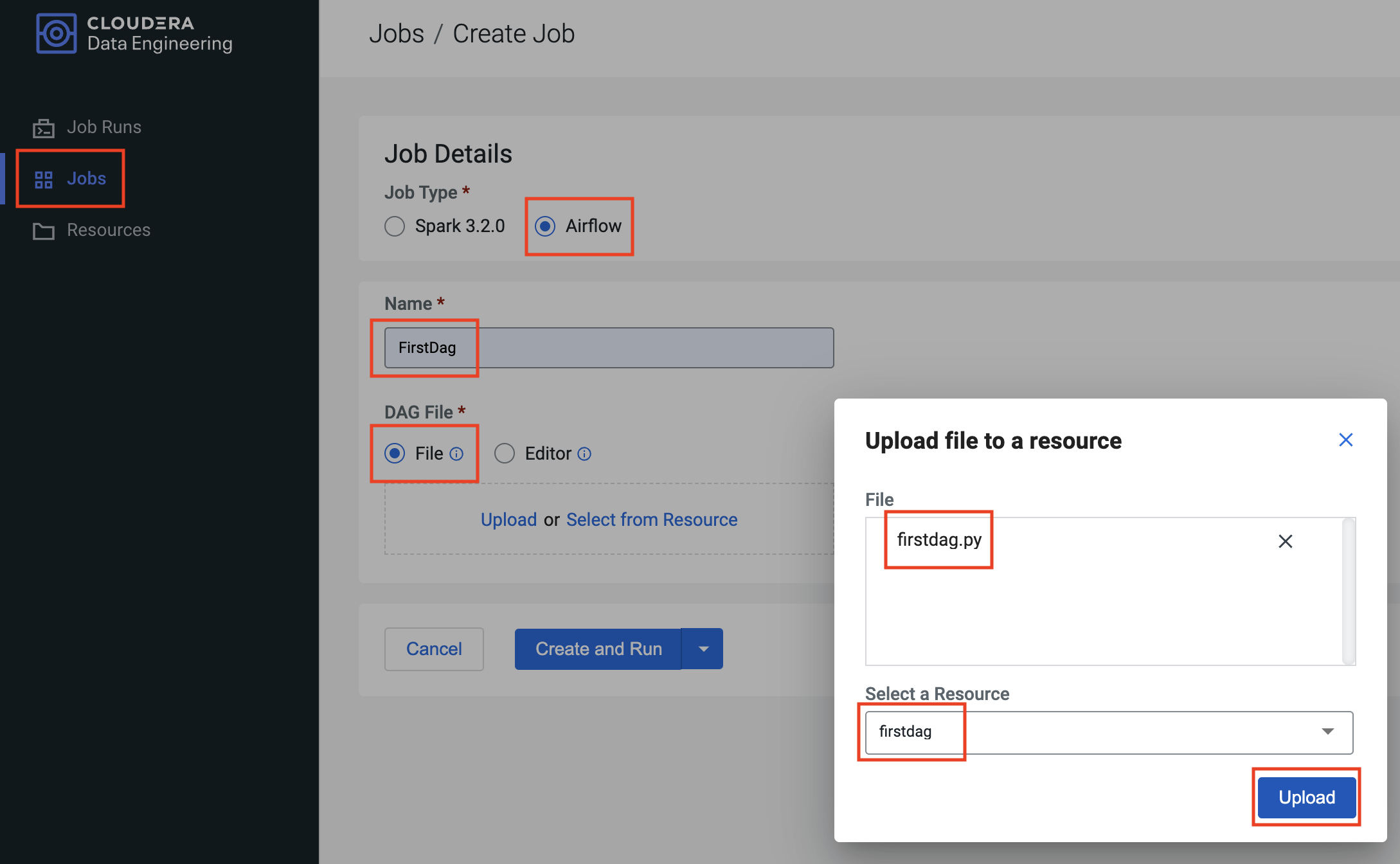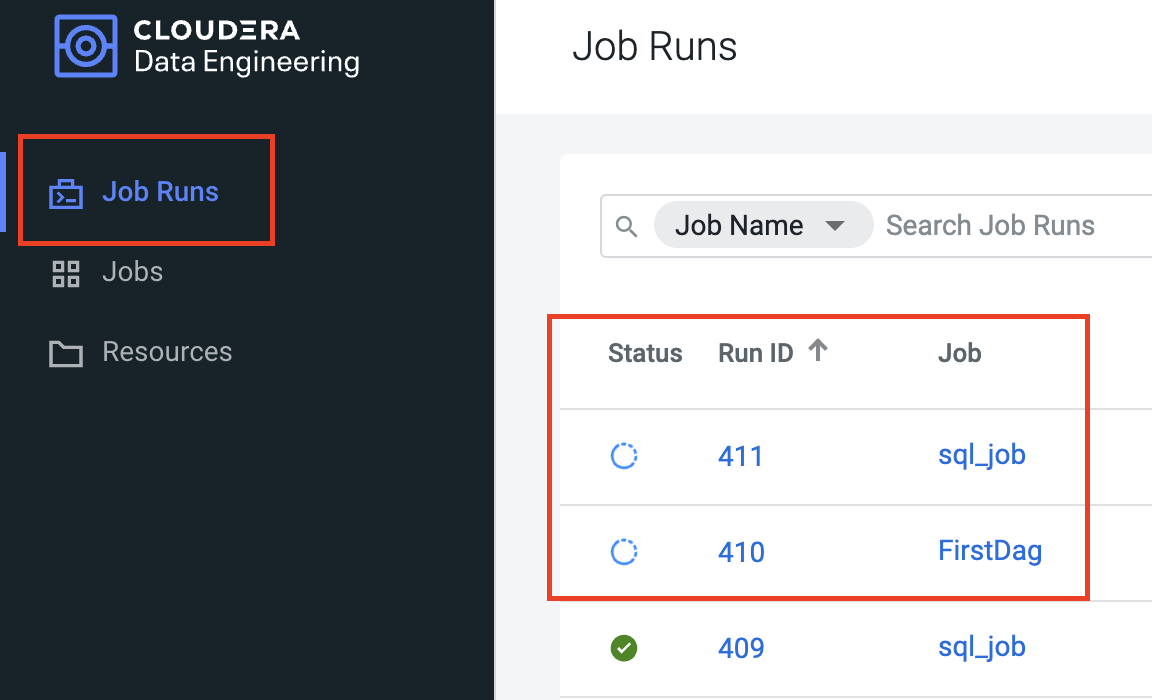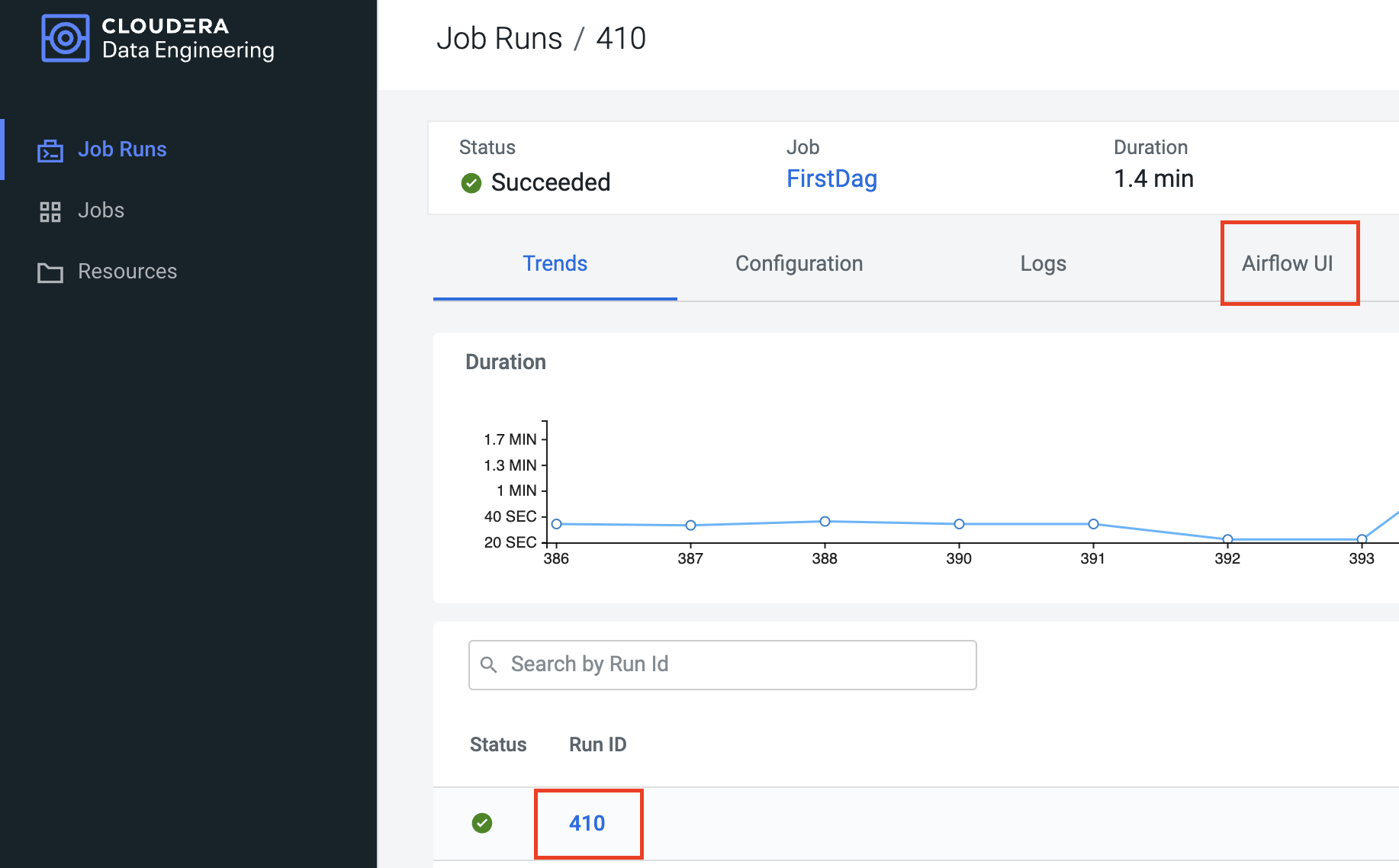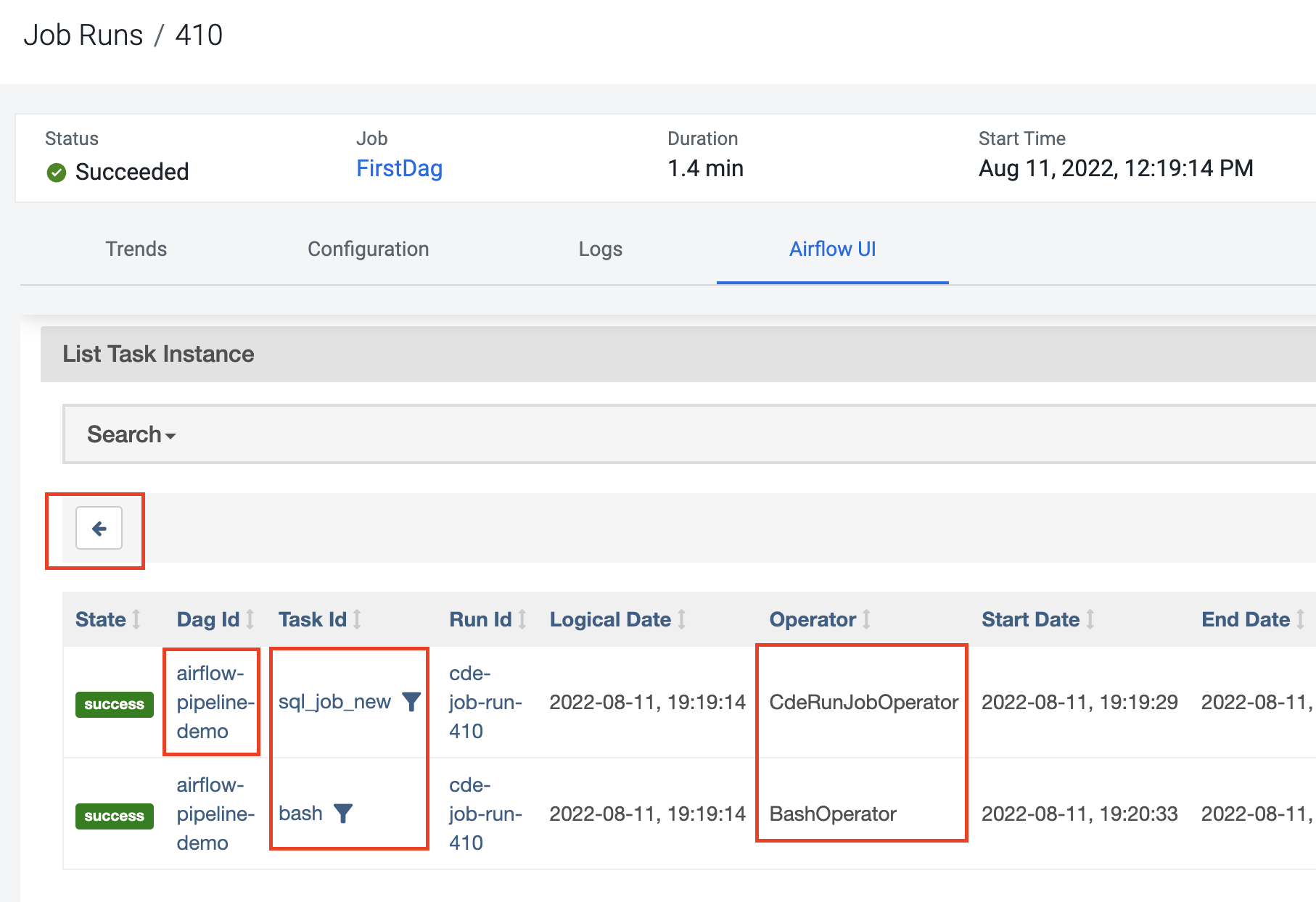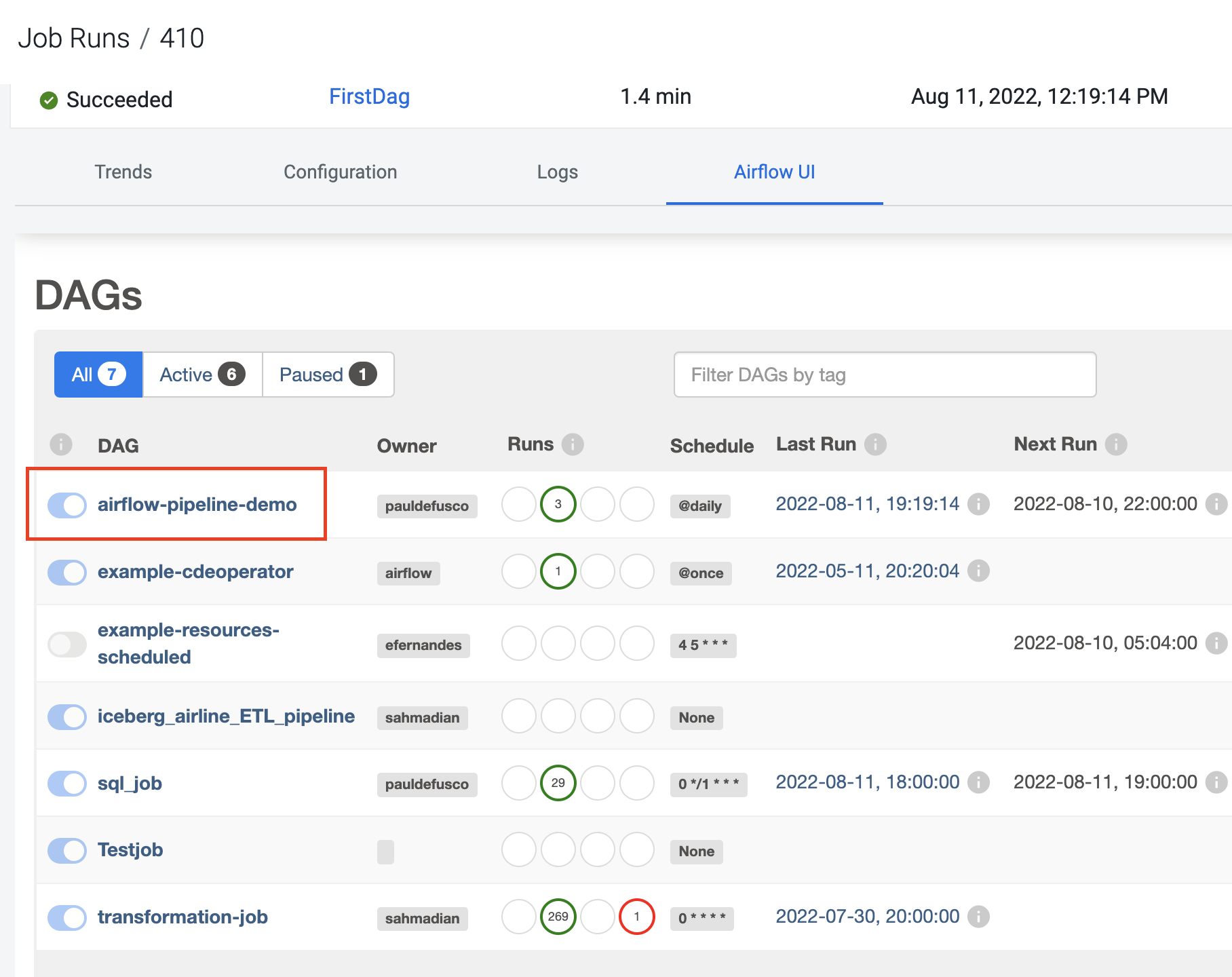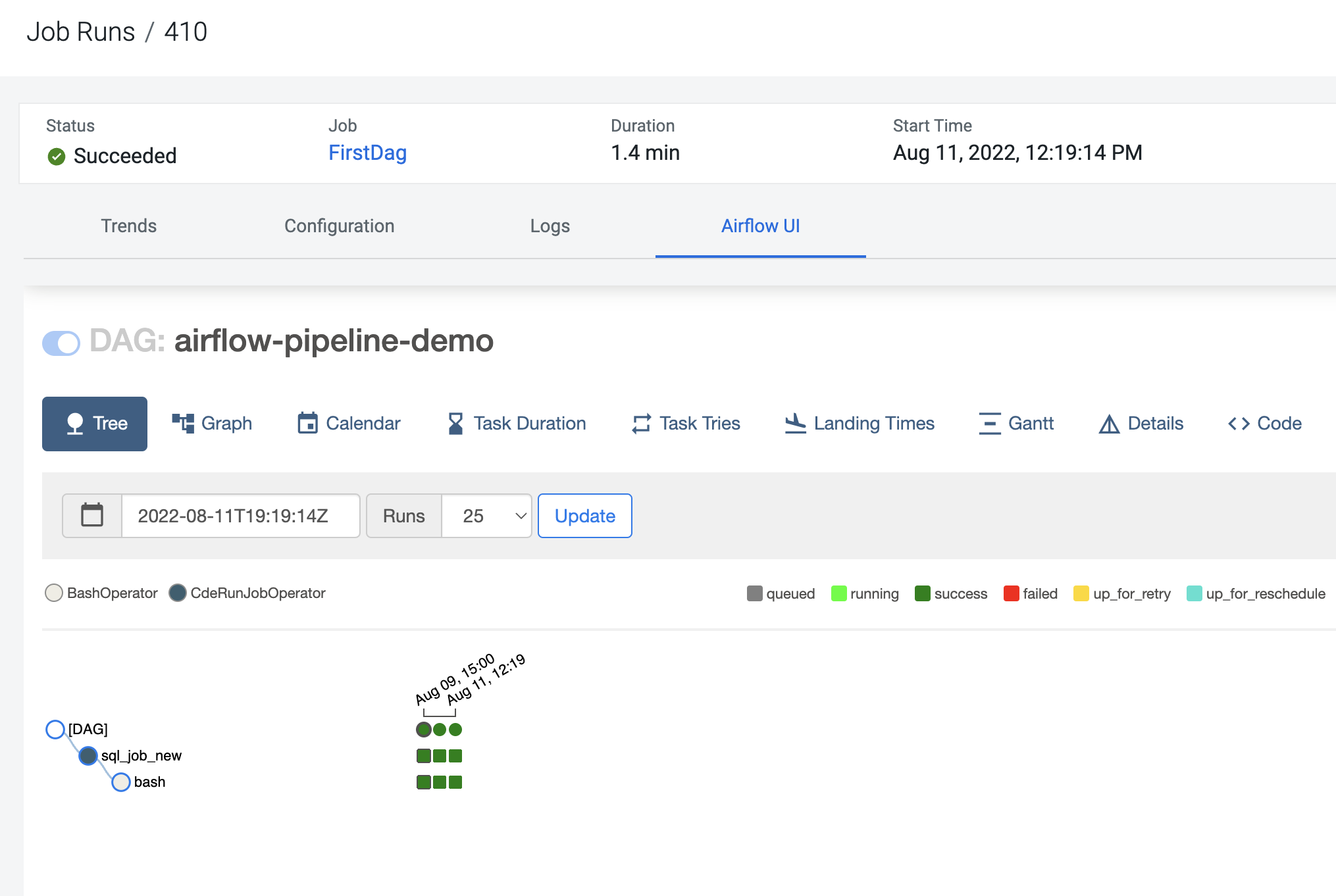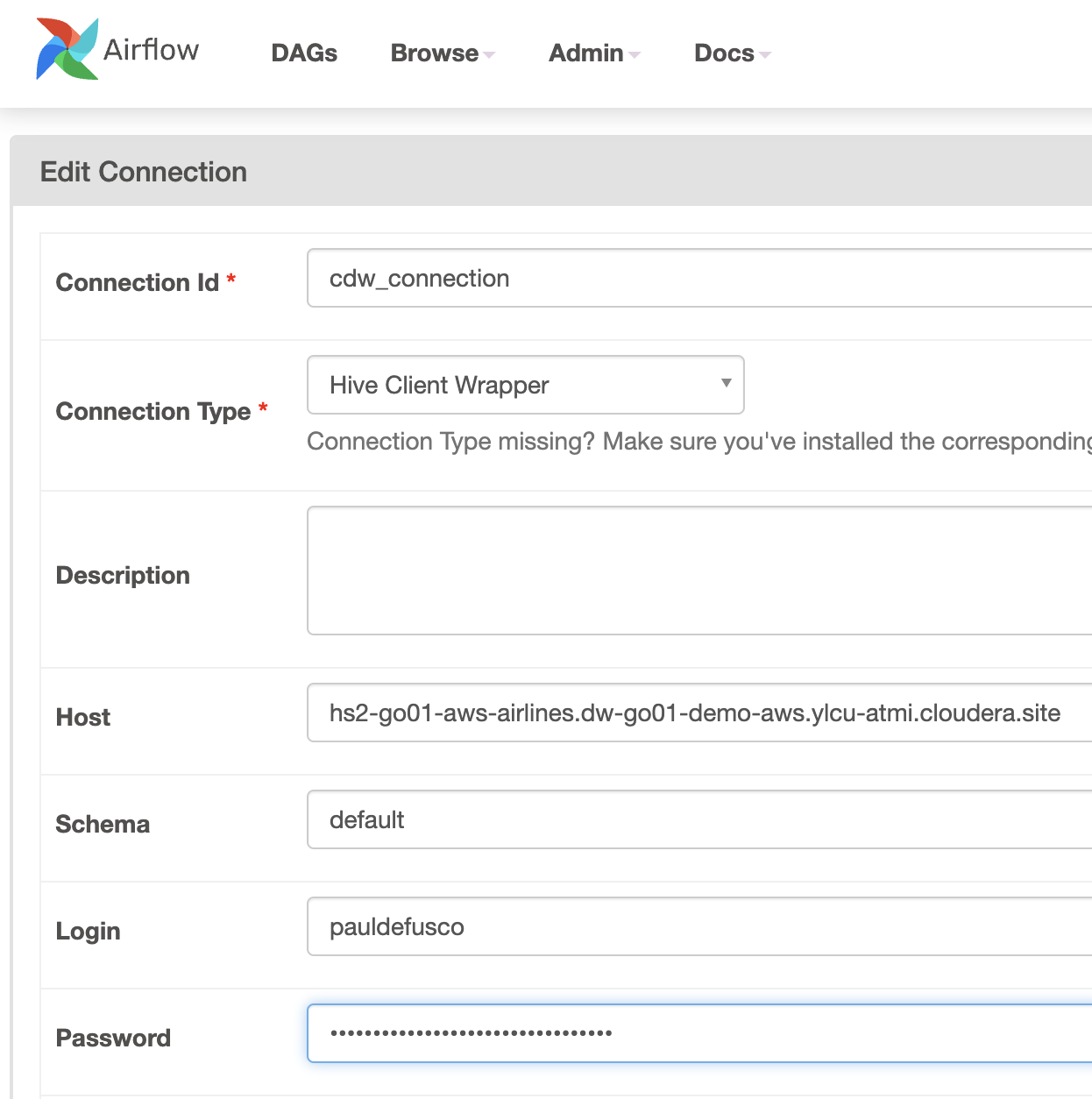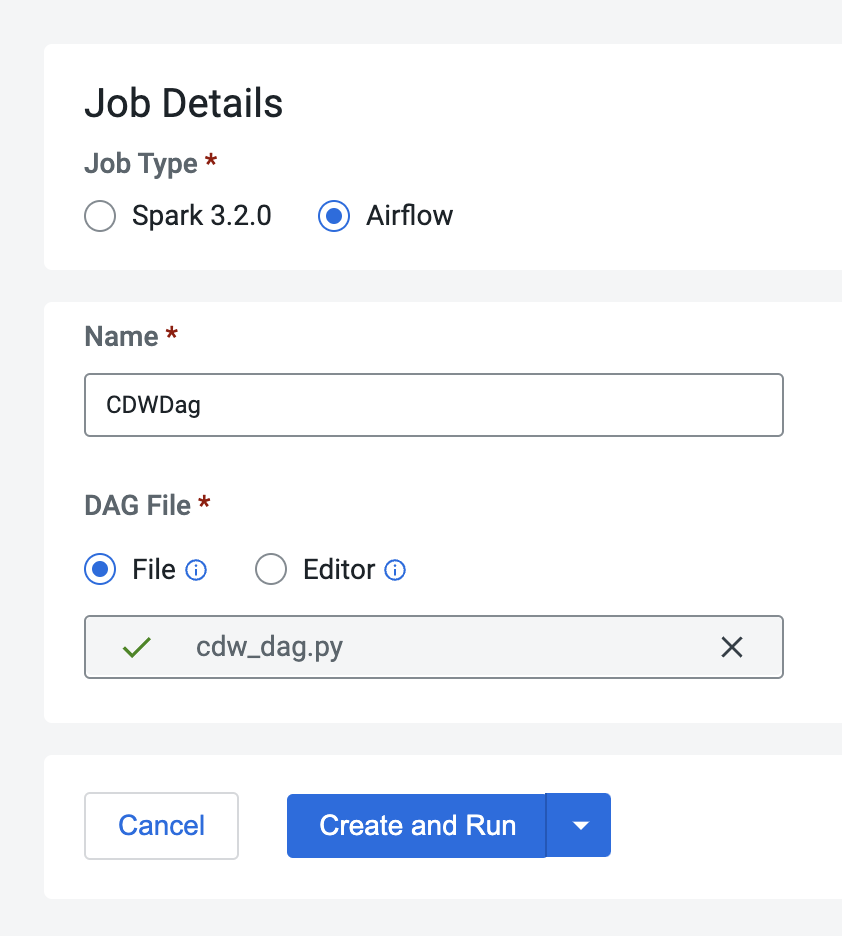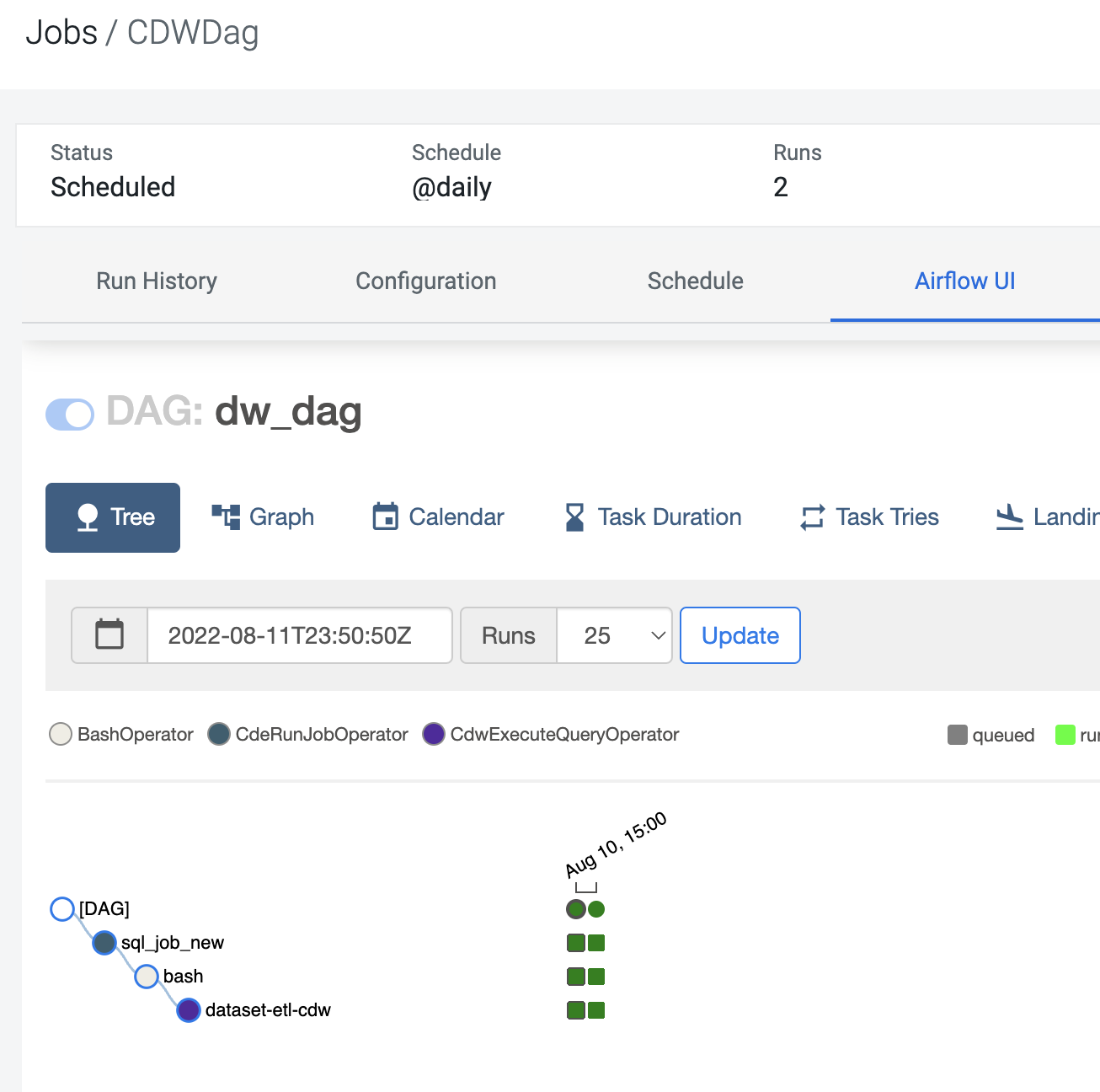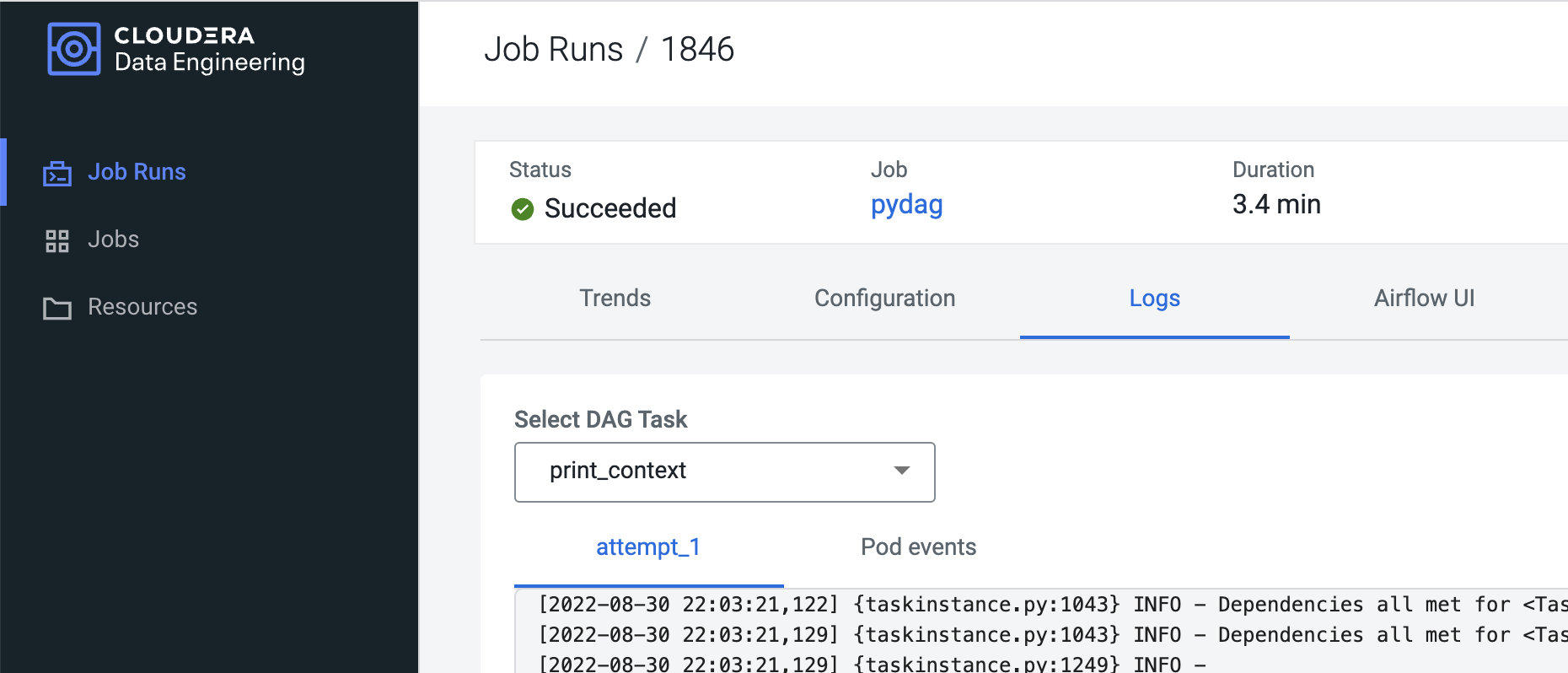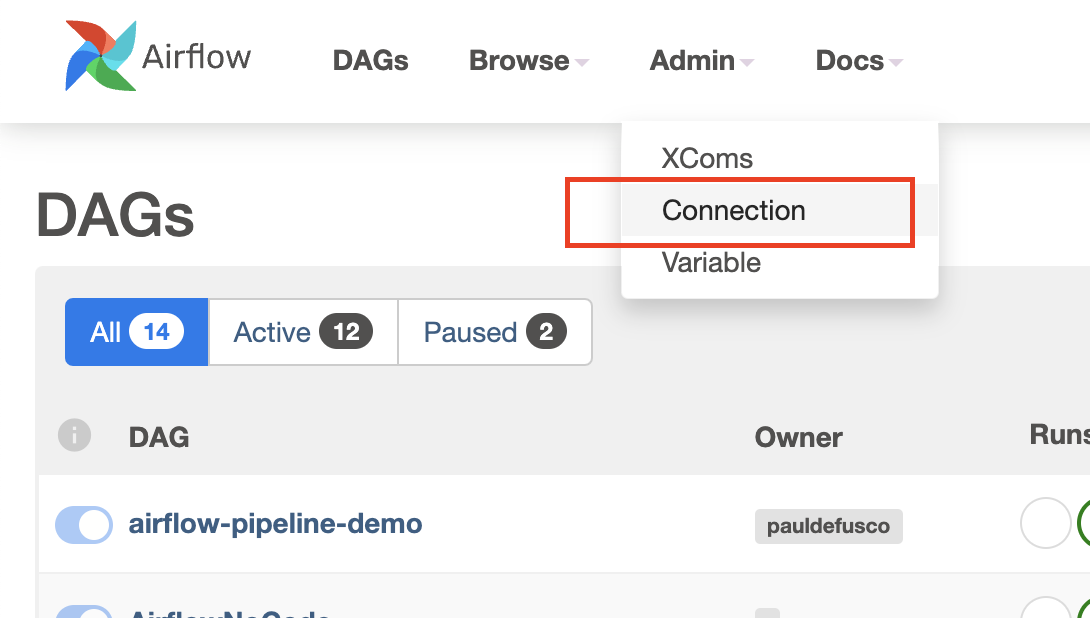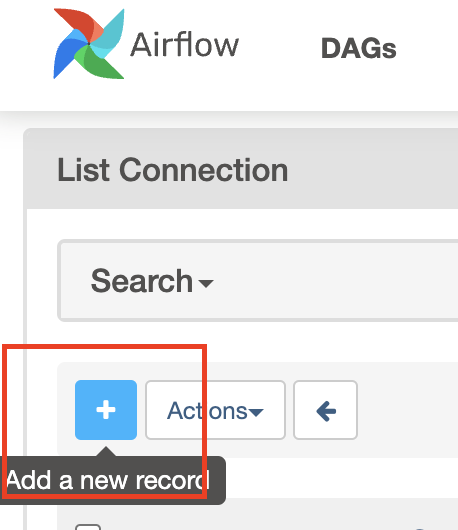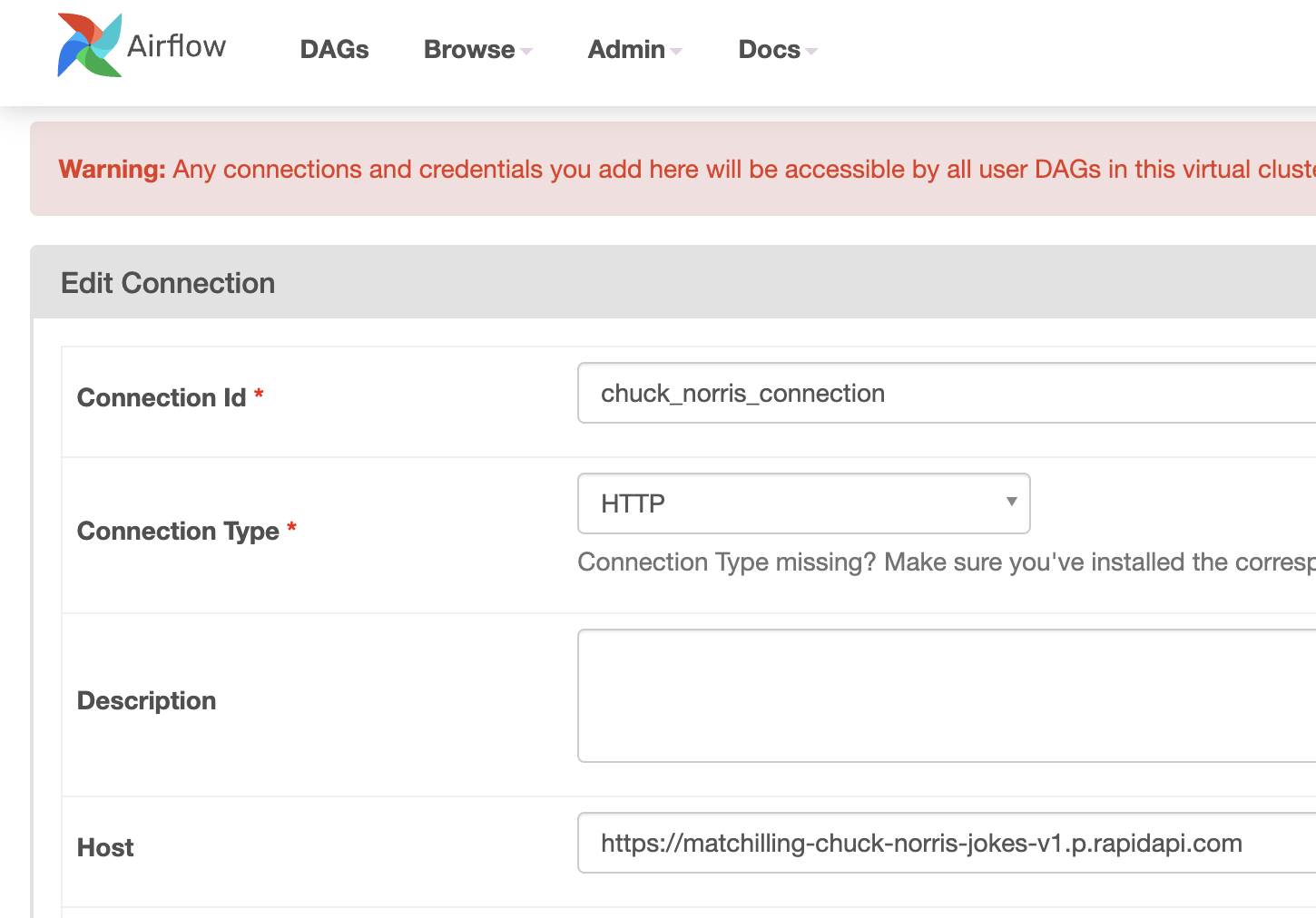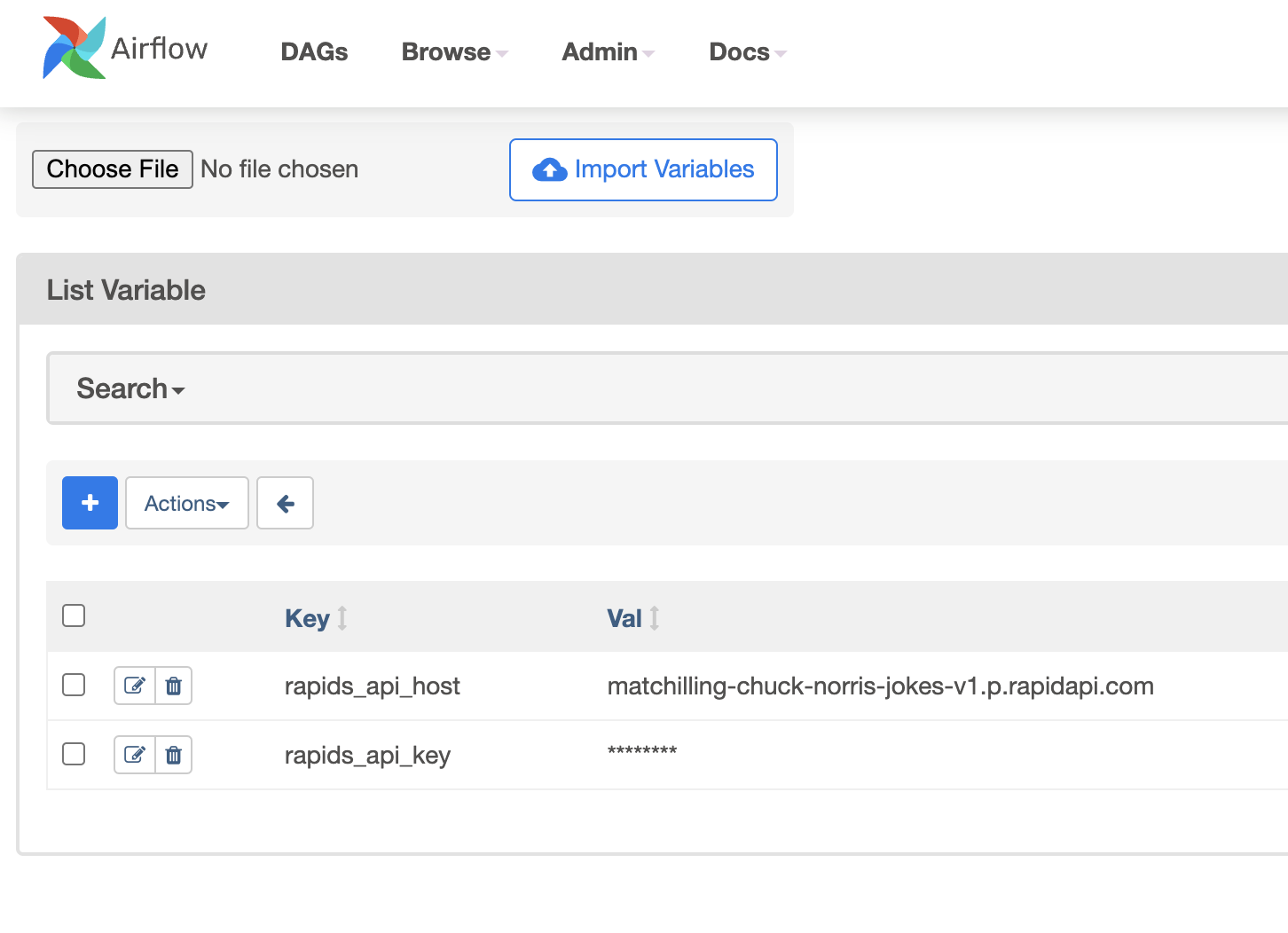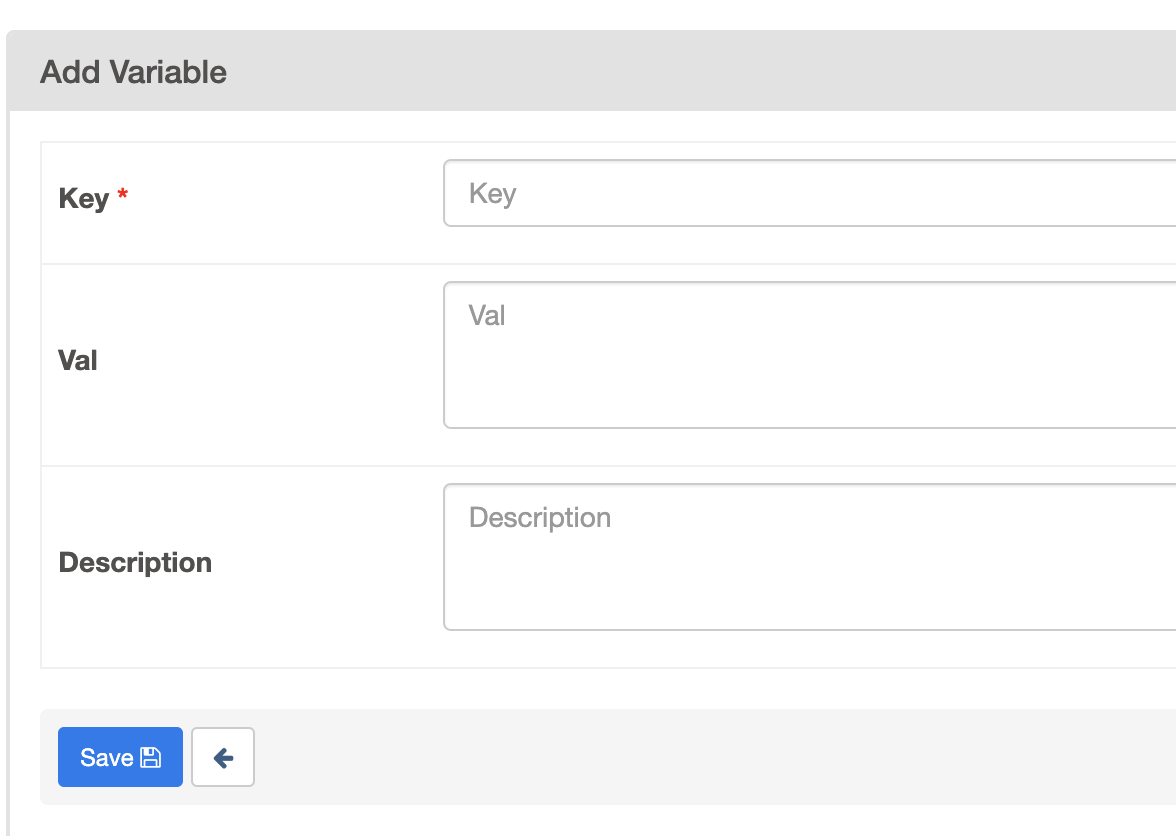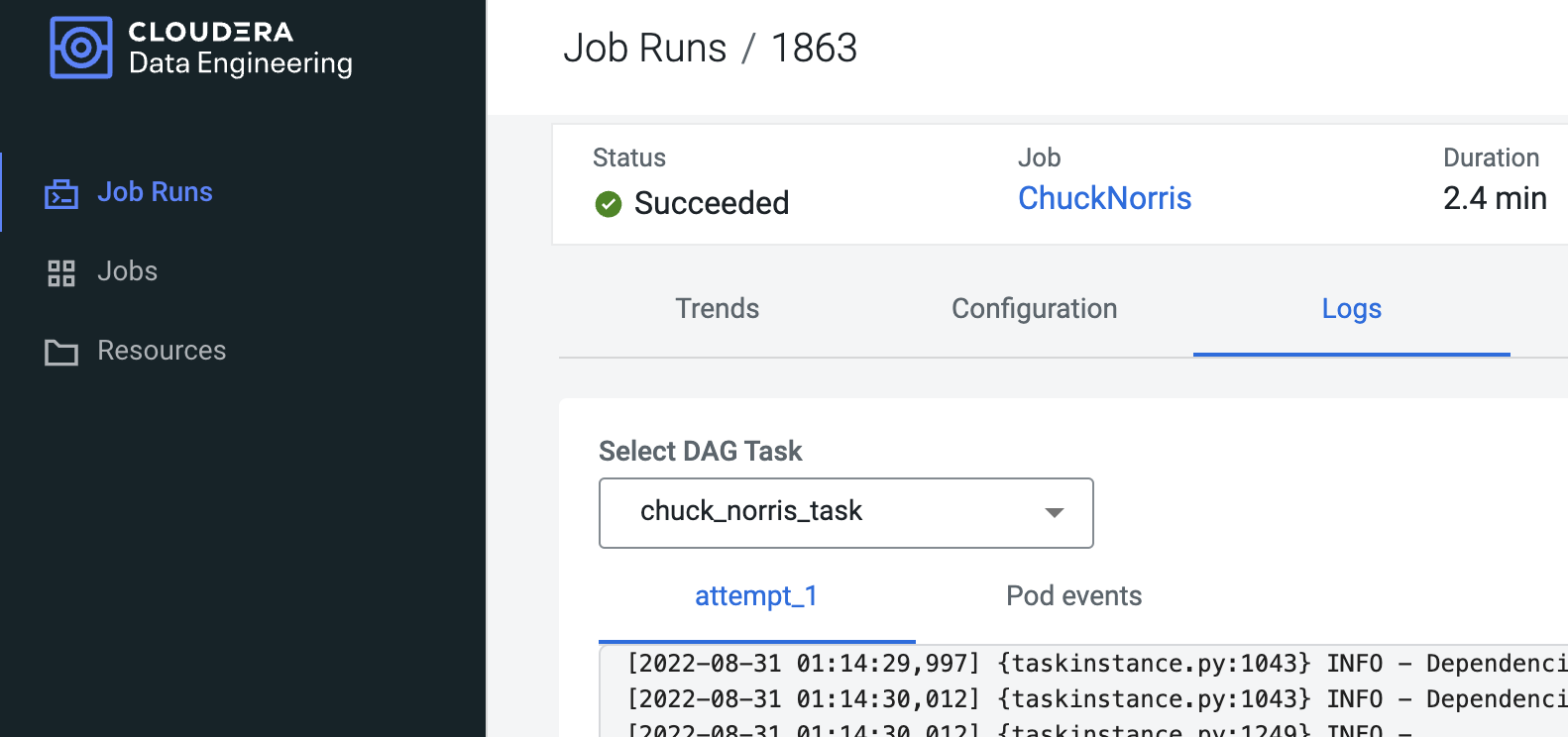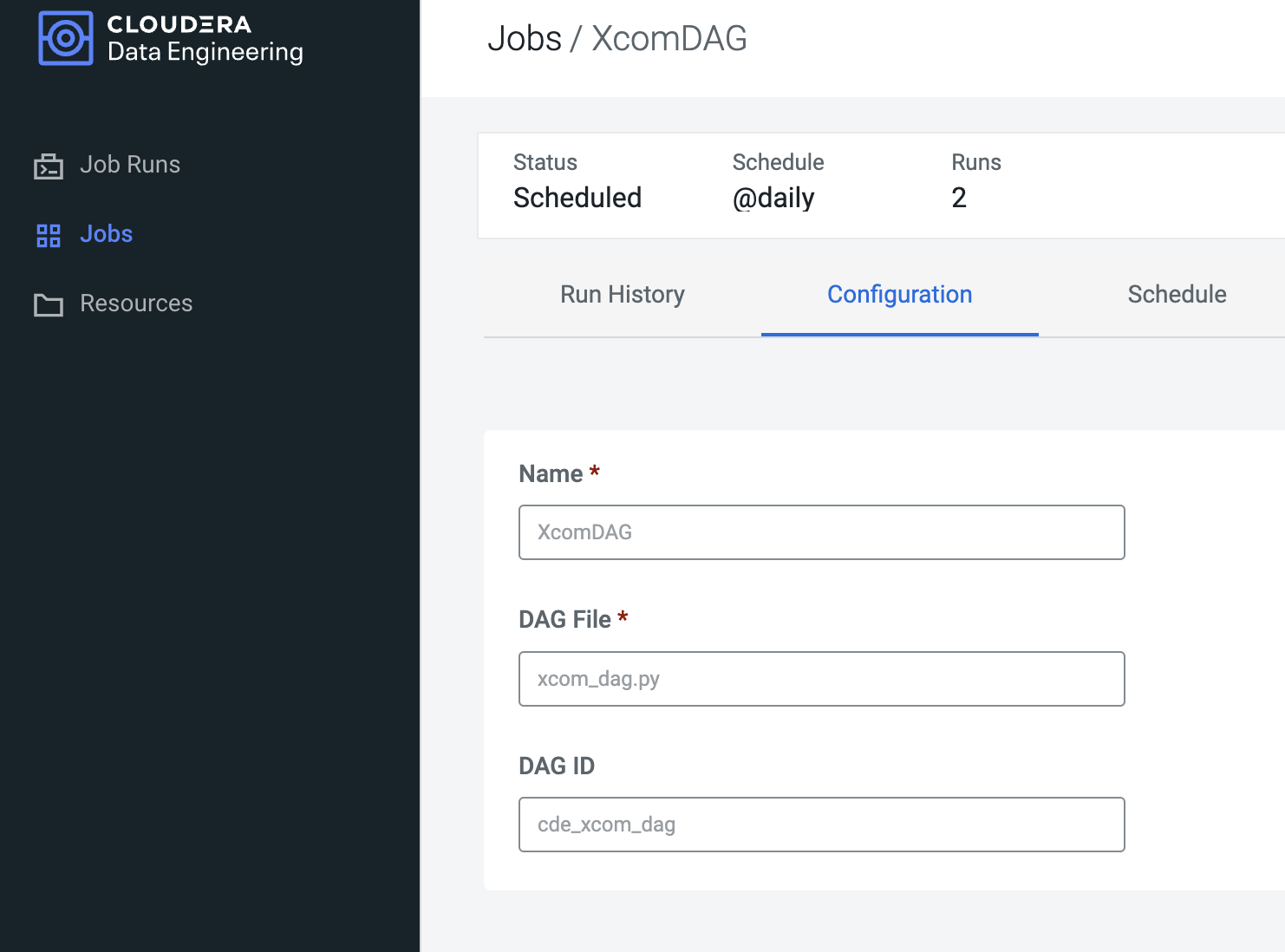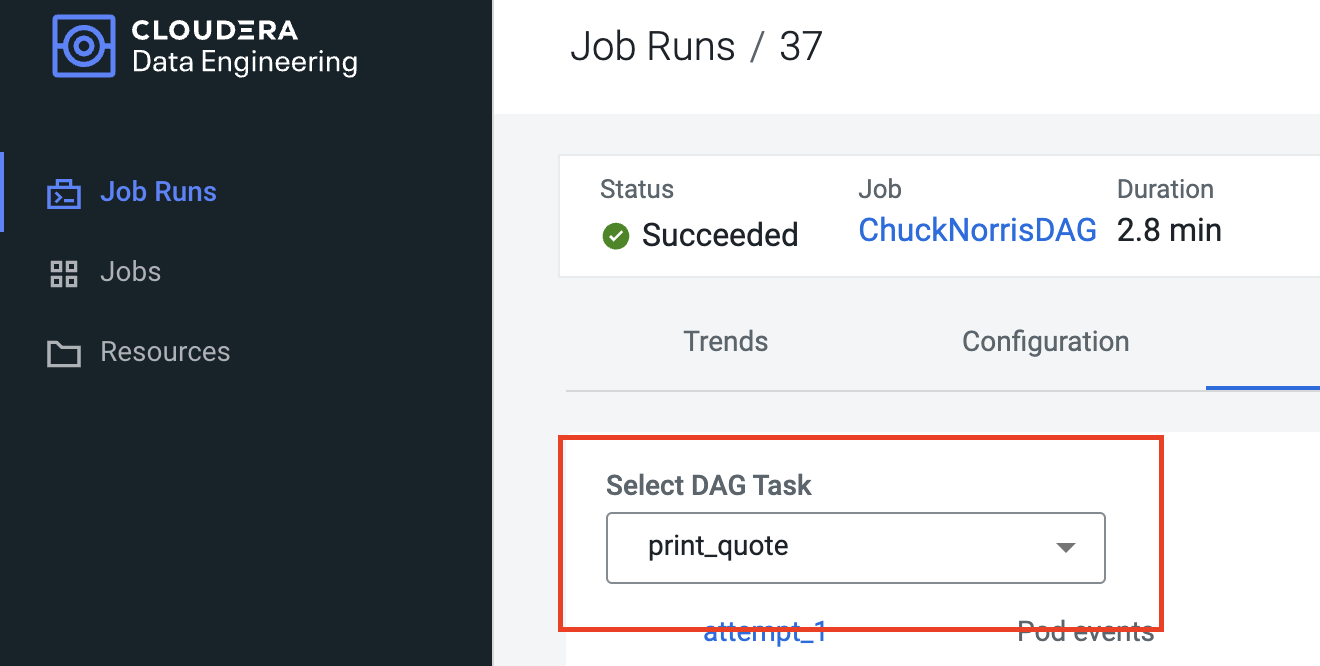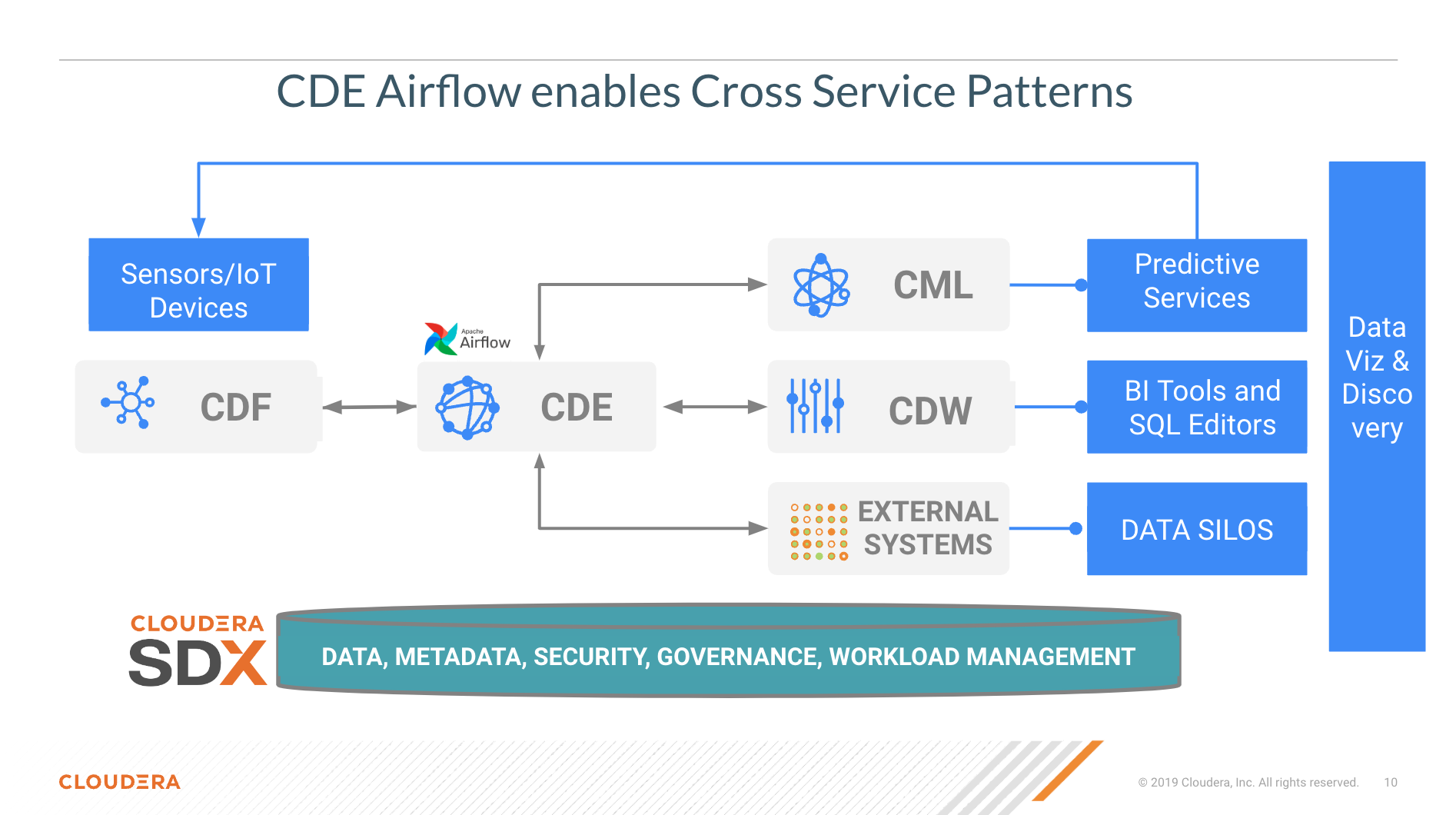This tutorial provides a reference of Airflow features and capabilities in CDE, the Cloudera Data Enginereering Service available in CDP Public and Private Cloud.
Apache Airflow is a platform to author, schedule and execute Data Engineering pipelines. It is widely used by the community to create dynamic and robust workflows for batch Data Engineering use cases.
CDE embeds Apache Airflow at the CDE Virtual Cluster level. It is automatically deployed for the CDE user during CDE Virtual Cluster creation and requires no maintenance on the part of the CDE Admin.
In order to follow the steps you need:
- A CDE Virtual Cluster either in CDP Public or Private Cloud.
- Recommended: familiarity with the Python Programming Language.
- Recommended: knowledge of the CDE CLI. If this is new, you can complete this introduction or this advanced guide.
- Optional: a CDW Virtual Cluster. This will be required by the steps covering the Airflow CDW Operator to run Impala and Hive queries.
- Airflow Concepts
- Getting Started with Airflow in CDE
- Beyond Airflow for Spark Jobs
- More Airflow DAG Features
- Airflow Job Management with the CDE API and CLI
- CDE Airflow FAQs
In Airflow, a DAG (Directed Acyclic Graph) is defined in a Python script, which represents the DAGs structure (tasks and their dependencies) as code.
For example, a simple DAG could consist of three tasks: A, B, and C. It could say that A has to run successfully before B can run, but C can run anytime. It could say that task A times out after 5 minutes, and B can be restarted up to 5 times in case it fails. It might also say that the workflow will run every night at 10pm, but shouldn’t start until a certain date.
For more information about Airflow DAGs reference the Apache Airflow documentation. For an example DAG in CDE reference the CDE Cloudera documentation.
The Airflow UI makes it easy to monitor and troubleshoot your data pipelines. For a complete overview of the Airflow UI reference the Apache Airflow documentation.
CDE Jobs can be of two types: Spark and Airflow. Airflow CDE Jobs are typically used to orchestrate Spark CDE Jobs as well as other Data Engineering actions.
CDE Jobs of type Airflow consist primarily of an Airflow DAGs contained in a Python file. More on DAGs below.
There are three ways to build an Airflow CDE Job:
- Using the CDE Web interface. For more information, see Running Jobs in Cloudera Data Engineering.
- Using the CDE CLI tool. For more information, see Using the Cloudera Data Engineering command line interface.
- Using CDE Rest API endpoints. For more information, see CDE API Jobs
In addition, you can automate migrations from Oozie on CDP Public Cloud Data Hub, CDP Private Cloud Base, CDH and HDP to Spark and Airflow CDE Jobs with the oozie2cde API.
CDE packages the open source version of Airflow. Airflow is maintained and upgraded at each CDE version update. For example, CDE 1.16 includes Airflow 2.2.5.
CDE Airflow supports only the core Airflow operators and does not provide the ability to install additional components (yet). Within this boundary, users are free to implement Airflow DAGs as needed.
Furthemore, Cloudera supports two operators that it contributed to the Airflow Community:
- CDE Operator: used to orchestrate Spark CDE Jobs. This has no requirements other than creating a Spark CDE Job separately and then referencing it within the Airflow DAG syntax.
- CDW Operator: used to orchestrate CDW Hive or Impala queries. This requires a Cloudera Virtual Warehouse and setting up an Airflow connection to it.
For an example DAG in CDE using the two operators reference the CDE Cloudera documentation.
From your Virtual Cluster Service Details page, open the Airflow UI by clicking on the related icon as shown below.
We will start with a simple Airflow DAG that executes a Spark CDE Job and a shell command.
We will work with the following artifacts:
- A python file containing Airflow DAG. This is provided under cde_jobs/firstdag.py.
- A pythong file containing a PySpark job. This is provided under cde_jobs/sql.py.
Navigate to the CDE Virtual Cluster page.
Open the Jobs UI and click on "Create Job" on the right side.
Now fill out the form. Pick "sql.py" as your spark job file. Then, you will be prompted to select a resource. Create a new one with name "firstdag".
Resources are repositories inside the Virtual Cluster where you can store files, dependencies, and manage python environments.
For more info on resources, please visit the CDE Documentation.
At the bottom of the form, make sure to select "Create" rather than "Create and Run" by clicking on the down arrow first.
The Spark CDE Job is now available in the Jobs UI.
In your editor, open the "firstdag.py" file located in the cde_jobs folder.
Let's go over the code. Between lines 2 and 7 we import the Python modules needed for the DAG. Notice that at line 6 and 7 we import the CDEJobRunOperator and BashOperator. The CDEJobRunOperator was created by Cloudera to support Spark CDE Job. The BashOperator is used to perform shell actions inside an Airflow DAG.
from datetime import datetime, timedelta
from dateutil import parser
import pendulum
from airflow import DAG
from cloudera.cdp.airflow.operators.cde_operator import CDEJobRunOperator
from airflow.operators.bash import BashOperator
Between lines 8 and 22 we declare the DAG and its arguments.
The arguments dictionary includes options for scheduling, setting dependencies, and general execution. For a comprehensive list of DAG arguments please consult this page in the documentation.
Once the arguments dictionary is complete it is passed as an argument to the DAG object instance.
default_args = {
'owner': 'yourCDPusername',
'retry_delay': timedelta(seconds=5),
'depends_on_past': False,
'start_date': pendulum.datetime(2020, 1, 1, tz="Europe/Amsterdam")
}
firstdag = DAG(
'airflow-pipeline-demo',
default_args=default_args,
schedule_interval='@daily',
catchup=False,
is_paused_upon_creation=False
)
Between lines 24 and 28 an instance of the CDEJobRunOperator obect is declared with the following arguments:
- Task ID: This is the name used by the Airflow UI to recognize the node in the DAG.
- DAG: This has to be the name of the DAG object instance declared at line 16.
- Job Name: This has to be the name of the Spark CDE Job created in step 1 above.
spark_step = CDEJobRunOperator(
task_id='spark_sql_job',
dag=firstdag,
job_name='sql_job'
)
Between lines 30 and 34 we declare an instance of the BashOperator object with the following arguments:
- Task ID: as above, you can pick an arbitraty string value
- DAG: This has to be the name of the DAG object instance declared at line 16.
- Bash Command: the actual shell commands you want to execute.
Notice that this is just a simple example. You can optionally add more complex syntax with Jinja templating, use DAG variables, or even trigger shell scripts. For more please visit the Airflow Bash Operator documentation.
shell = BashOperator(
task_id='bash',
dag=firstdag,
bash_command='echo "Hello Airflow" '
)
Finally, at line 36 we declare Task Dependencies. With this statement you can specify the execution sequence of DAG tasks.
spark_step >> shell
Before moving on, make sure to open the DAG python file in your editor and replace the current value of the 'Owner' with your CDP Username in the default arguments dictionary. No other changes are required at this time.
Navigate back to the CDE Jobs page and create a new CDE Job. Make sure to pick the following settings:
- Type: Airflow
- Name: FirstDag
- Dag File: Select type "File" and then upload "firstdag.py" to the firstdag CDE Resource you created earlier.
Select "Create and Run" to trigger the job immediately.
Navigate to the CDE Job Runs page and notice two CDE Jobs are now in progress. One of them is "sql_job" (Spark CDE Job) and the other is "FirstDag" (Airflow CDE Job). The former has been triggered by the execution of the latter. Wait a few moments and allow for the DAG to complete.
Next, click on the "FirstDag" link shown in the above screenshot to access the Job Run page. This page shows each run along with associated logs, execution statistics, and the Airflow UI.
Ensure to select the most recent Run (in the below screenshot number 410) and then click on the Airflow UI tab.
The first landing page lists all tasks along with their status. Notice that the DAG ID, Task ID and Operator columns are populated with the values set in the DAG python files. Next, click on the back arrow on the left side of the screen to navigate to the Airflow UI DAGs view.
From the DAGs view you can:
- Pause/unpause a DAG
- Filter the list of DAGs to show active, paused, or all DAGs
- Trigger, refresh, or delete a DAG
- Navigate quickly to other DAG-specific pages
Identify the DAG by the name you specified in the python file during DAG declaration. Click on it to open the Airflow UI DAG view to drill down with DAG-specific pages.
Here, Airflow provides a number of tabs to increase job observability. Below is a brief explanation of the most important once.
The Tree View tracks DAG tasks across time. Each column represents a DAG Run and each square is a task instance in that DAG Run. Task instances are color-coded depending on success of failure. DAG Runs with a black border represent scheduled runs while DAG Runs with no border are manually triggered.
The Graph View shows a simpler diagram of DAG tasks and their dependencies for the selected run. You can enable auto-refresh the view to see the status of the tasks update in real time.
The Calendar View shows the state of DAG Runs overlaid on a calendar.
The Code View shows the code that is used to generate the DAG. This is the DAG python file we used earlier.
The CDWRunOperator was contributed by Cloudera in order to orchestrate CDW queries with Airflow.
Before we can use it in the DAG we need to connect Airflow to CDW. To complete these steps, you must have access to a CDW virtual warehouse. CDE currently supports CDW operations for ETL workloads in Apache Hive virtual warehouses. To determine the CDW hostname to use for the connection:
-
Navigate to the Cloudera Data Warehouse Overview page by clicking the Data Warehouse tile in the Cloudera Data Platform (CDP) management console.
-
In the Virtual Warehouses column, find the warehouse you want to connect to.
-
Click the three-dot menu for the selected warehouse, and then click Copy JDBC URL.
-
Paste the URL into a text editor, and make note of the hostname. For example, starting with the following url the hostname is shown below:
Original URL: jdbc:hive2://hs2-aws-2-hive.env-k5ip0r.dw.ylcu-atmi.cloudera.site/default;transportMode=http;httpPath=cliservice;ssl=true;retries=3;
Hostname: hs2-aws-2-hive.env-k5ip0r.dw.ylcu-atmi.cloudera.site
-
Navigate to the Cloudera Data Engineering Overview page by clicking the Data Engineering tile in the Cloudera Data Platform (CDP) management console.
-
In the CDE Services column, select the service containing the virtual cluster you are using, and then in the Virtual Clusters column, click Cluster Details for the virtual cluster.
-
Click AIRFLOW UI.
-
From the Airflow UI, click the Connection link from the Admin menu.
-
Click the plus sign to add a new record, and then fill in the fields:
- Conn Id: Create a unique connection identifier, such as "cdw_connection".
- Conn Type: Select Hive Client Wrapper.
- Host: Enter the hostname from the JDBC connection URL. Do not enter the full JDBC URL.
- Schema: default
- Login: Enter your workload username and password.
- Click Save.
Now you are ready to use the CDWOperator in your Airflow DAG. In your editor make a copy of "firstdag.py" and name it "cdw_dag.py"
At the top, import the Operator along with other import statements:
from cloudera.cdp.airflow.operators.cdw_operator import CDWOperator
At the bottom of the file add an instance of the CDWOperator object.
cdw_query = """
show databases;
"""
dw_step3 = CDWOperator(
task_id='dataset-etl-cdw',
dag=example_dag,
cli_conn_id='cdw_connection',
hql=cdw_query,
schema='default',
use_proxy_user=False,
query_isolation=True
)
Notice that the SQL syntax run in the CDW Virtual Warehouse is declared as a separate variable and then passed to the Operator instance as an argument.
Finally, update task dependencies to include "dw_step3":
spark_step >> shell >> dw_step3
DAG names are stored in Airflow and must be unique. Therefore, change the variable name of the DAG object instance to "airflow_cdw_dag" and the DAG ID to "dw_dag" as shown below.
airflow_cdw_dag = DAG(
'dw_dag',
default_args=default_args,
schedule_interval='@daily',
catchup=False,
is_paused_upon_creation=False
)
Notice the new DAG variable needs to be updated in each Operator as well. The completed DAG file is included in the cde_jobs folder for your convenience.
Next, create a new Airflow CDE Job named "CDW Dag". Upload the new DAG file to the same or a new CDE resource as part of the creation process.
Navigate to the CDE Job Runs Page and open the run's Airflow UI. Then open the Tree View and validate that the job has succeeded.
When Airflow runs a task, it collects several variables and passes these to the context argument on the execute() method. These variables hold information about the current task.
Open the "bash_dag.py" file and examine the contents. Notice that at lines 52-56 a new instance of the BashOperator has been declared with the following entries:
also_run_this = BashOperator(
task_id='also_run_this',
dag=bash_airflow_dag,
bash_command='echo "yesterday={{ yesterday_ds }} | today={{ ds }}| tomorrow={{ tomorrow_ds }}"',
)
Above we printed the "yesterday_ds", "ds" and tomorrow_ds" dates. There are many more and you can find the full list here
Variables can also be saved and reused by other operators. We will explore this in the section on XComs in section 4.
The PythonOperator allows you to run Python code inside the DAG. This is particularly helpful as it allows you to customize your DAG logic in a variety of ways.
The PythonOperator requires implementing a callable inside the DAG file. Then, the method is called from the operator.
Lines 60-67 in "py_dag.py" show how to use the operator to print out all Conext Variables in one run.
def _print_context(**context):
print(context)
print_context = PythonOperator(
task_id="print_context",
python_callable=_print_context,
dag=dag,
)
Execute the DAG and once it completes open the run in the Job Runs page. Ensure to select the correct Airflow task which in this case is "print_context":
Scroll to the bottom and validate the output.
You can use the SimpleHttpOperator to call HTTP requests and get the response text back. The Operator can help when you need to interact with 3rd party systems, APIs, and perform actions based on complex control flow logic.
In the following example we will send a request to the Chuck Norris API from the Airflow DAG. Before updating the DAG file, we need to set up a new Airflow Connection and Airflow Variables.
- Navigate to the CDE Virtual Cluster Service Details page and then open the Airflow UI.
- Open the Connections page under the Admin tab.
- Add a new connection
- Configure the connection by entering the following values for the following parameters. Leave the remaining entries blank.
* Connection ID: chuck_norris_connection
* Connection Type: HTTP
* Host: https://matchilling-chuck-norris-jokes-v1.p.rapidapi.com/
- Save the new connection and close the Airflow UI.
Airflow Variables allow you to parameterize your operators. Airflow Variables are used as environment variables for the DAG. Therefore, if you are looking to temporarily store operator results in the DAG and pass values to downstream operators you should use XComs (shown in the next section).
In our example, we will use them to pass an API KEY and HOST value to the SimpleHttpOperator below. To set up Airflow Variables, navigate back to the CDE Virtual Cluster Service Details page and open the Airflow UI.
Then, click on the "Variables" tab under the "Admin" drop down at the top of the page.
Create two variables wit the following entries:
First Variable:
* Key: rapids_api_host
* Value: matchilling-chuck-norris-jokes-v1.p.rapidapi.com
Second Variable:
* Key: rapids_api_key
* Value: f16c49e390msh7e364a479e33b3dp10fff7jsn6bc84b000b75
Next, open "http_dag.py" and familiarize yourself with the code. The code relevant to the new oerator is used between lines 71 and 92.
- Notice that at line 11 we are importing the Variable type from the airflow.models module.
- We are then creating two Airflow Variables at lines 72 and 73.
- The "http_conn_id" parameter is mapped to the Connection ID you configured in the prior step.
- The "response_check" parameter allows you to specify a python method to validate responses. This is the "handle_response" method declared at line 71.
api_host = Variable.get("rapids_api_host")
api_key = Variable.get("rapids_api_key")
def handle_response(response):
if response.status_code == 200:
print("Received 200 Ok")
return True
else:
print("Error")
return False
http_task = SimpleHttpOperator(
task_id="chuck_norris_task",
method="GET",
http_conn_id="chuck_norris_connection",
endpoint="/jokes/random",
headers={"Content-Type":"application/json",
"X-RapidAPI-Key": api_key,
"X-RapidAPI-Host": api_host},
response_check=lambda response: handle_response(response),
dag=http_dag
)
As before, execute the DAG as a new CDE Job and validate results for the "http_task" under the Job Runs Logs tab.
Although the request in the prior step was successful the operator did not actually return the response to the DAG. XComs (short for “cross-communications”) are a mechanism that let Tasks talk to each other, as by default Tasks are entirely isolated and may be running on entirely different machines.
Practically XComs allow your operators to store results into a governed data structure and then reuse the values within the context of different operators. An XCom is identified by a key (essentially its name), as well as the task_id and dag_id it came from. They are only designed for small amounts of data; do not use them to pass around large values, like dataframes.
Open "xcom_dag.py" and familiarize yourself with the code. Notice the following changes in the code between lines 82 and 103:
- At line 92 we added a "do_xcom_push=True" argument. This allows the response to be temporarily saved in the DAG.
- At line 95 we introduced a new Python method "_print_chuck_norris_quote" and at line 96 we use the built-in "xcom_pull" method to retrieve the temporary value from the SimpleHttpOperator task.
- At line 97 we declare a new Python Operator runnint the method above.
http_task = SimpleHttpOperator(
task_id="chuck_norris_task",
method="GET",
http_conn_id="chuck_norris_connection",
endpoint="/jokes/random",
headers={"Content-Type":"application/json",
"X-RapidAPI-Key": api_key,
"X-RapidAPI-Host": api_host},
response_check=lambda response: handle_response(response),
dag=xcom_dag,
do_xcom_push=True
)
def _print_chuck_norris_quote(**context):
return context['ti'].xcom_pull(task_ids='chuck_norris_task')
return_quote = PythonOperator(
task_id="print_quote",
python_callable=_print_chuck_norris_quote,
dag=xcom_dag
)
Using "xcom_dag.py", create a new Airflow DAG with the name "xcom_dag" and execute it.
Open the Job Run Logs page and select the "print_quote" task.
Scroll all the way down and validate that a Chuck Norris quote has been printed out. Which one did you get?
For Spark CDE Jobs, the CDE CLI provides an intuitive solution to create and manage Airflow CDE Jobs.
The CDE CLI commands to create a resource and upload files to it are identical as in the Spark CDE Job section.
Before you can work on the following steps you have to download the CDE CLI as shown here.
cde airflow submit my-airflow-job.py
Notice that the --application-file flag has been replaced with the --dag-file flag.
cde job create --name myairflowjob --type airflow --dag-file path/to/airflow_dag.py
As with the CDE CLI, this section builds on the prior examples on the CDE API with Spark CDE Jobs.
The payload now includes the argument “airflow” for the “type” parameter. For more details on building AIrflow CDE requests, refer to the Swagger API page.
curl -H "Authorization: Bearer $ACCESS_TOKEN" -X 'POST' \
'$JOBS_API_URL/jobs' \
-H 'accept: application/json' \
-H 'Content-Type: application/json' \
-d '{"type": "airflow", "airflow": {"dagFile": "my_dag.py"}, "identity": {"disableRoleProxy": true},"mounts": [{"dirPrefix": "/","resourceName": "oozie_migration"}],"name": "oozie2airflow_migration","retentionPolicy": "keep_indefinitely"}'
- Can you connect a CDE Airflow Instance to an Open Source instance outside of CDP/CDE?
Yes, if you have complex Airflow implementations and do not want to replace them with CDE Airflow you can run them in tandem as shown here.
- Can airflow be used to orchestrate workloads on Private cloud base?
Yes, please visit this github for a demonstration (coming soon).
- Can airflow be run as a standalone product in CDP?
As of CDE 1.16 you need a CDE Virtual Cluster to run CDE Airflow. An Airflow Only Service is on the product roadmap.
- Can I install some cloud native plugins into the version of airflow shipped by Cloudera?
You cannot install plugins in CDE Public Cloud however you can do so in CDE Private Cloud or pair up an Open Source Airflow instance with a CDE Airflow instance as shown here
- Can airflow be used to orchestrate workloads running outside CDP ?
Yes, we saw an example in section 4 of this tutorial but this can be done in a number of ways based on your use case. In general using HTTP Operators is the simplest way to connect via REST API, but Airflow provides many alternatives such as hooks, operators, and plugins.
- Is there any tooling that will help me convert Oozie workflows to Airflow DAGs?
Yes, the Oozie2CDE API can convert Oozie workflows to CDE Airflow and Spark Jobs. You can find out more here.
Don't find your question here? Please reach out to your Cloudera Account Team or submit your questions thorugh this form.
CDE is the Cloudera Data Engineering Service, a containerized managed service for Spark and Airflow. Each CDE virtual cluster includes an embedded instance of Apache Airflow.
With Airflow based pipelines users can now specify their data pipeline using a simple python configuration file.
A basic CDE Airflow DAG can be composed of a mix of hive and spark operators that automatically run jobs on CDP Data Warehouse (CDW) and CDE, respectively; with the underlying security and governance provided by SDX.
However, thanks to the flexibility of Airflow, CDE can also empower users with the ability to integrate with other CDP Data Services and 3rd party systems. For example, you can combine the operators we have seen above to create complex pipeleines across multiple domains such as Datawarehousing, Machine Learning, and much more.
If you are exploring CDE you may find the following tutorials relevant:
-
Spark 3 & Iceberg: a quick intro of Time Travel Capabilities with Spark 3
-
Simple Intro to the CDE CLI: A simple introduction to the CDE CLI for the
-
CDE CLI Demo: A more advanced CDE CLI reference with additional details for the CDE user who wants to move beyond the basics shown here.
-
GitLab2CDE: a CI/CD pipeline to orchestrate Cross Cluster Workflows - Hybrid/Multicloud Data Engineering
-
CML2CDE: a CI/CD Pipeline to deploy Spark ETL at Scale with Python and the CDE API
-
Postman2CDE: using the Postman API to bootstrap CDE Services
For more information on the Cloudera Data Platform and its form factors please visit this site.
For more information on migrating Spark jobs to CDE, please reference this guide.
If you have any questions about CML or would like to see a demo, please reach out to your Cloudera Account Team or send a message through this portal and we will be in contact with you soon.
